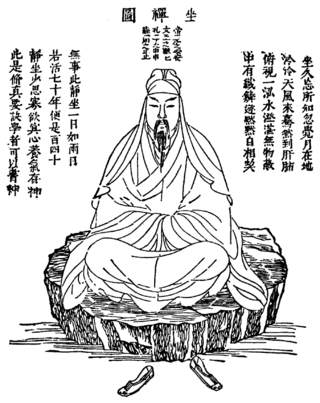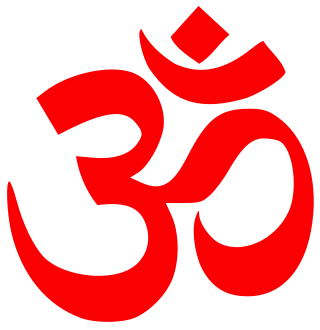
Lakshmi also known as Shri, is one of the principal goddesses in Hinduism. She is the goddess of wealth, fortune, power, beauty, fertility and prosperity, and associated with Maya ("Illusion"). Along with Parvati and Saraswati, she forms the Tridevi of Hindu goddesses.

A torana is a free-standing ornamental or arched gateway for ceremonial purposes in Hindu, Buddhist and Jain architecture of the Indian subcontinent. Toranas can also be widely seen in Southeast Asia and parts of East Asia. Chinese Shanmen gateways, Japanese torii gateways, Korean Iljumun and Hongsalmun gateways, Vietnamese Tam quan gateways, and Thai Sao Ching Cha were derived from the Indian torana. They are also referred to as vandanamalikas.

Korean Buddhism is distinguished from other forms of Buddhism by its attempt to resolve what its early practitioners saw as inconsistencies within the Mahayana Buddhist traditions that they received from foreign countries. To address this, they developed a new holistic approach to Buddhism that became a distinct form, an approach characteristic of virtually all major Korean thinkers. The resulting variation is called Tongbulgyo, a form that sought to harmonize previously arising disputes among scholars.
Buddhist temples are an important part of the Korean landscape. Most Korean temples have names ending in -sa, which means "monastery" in Sino-Korean. Many temples participate in the Templestay program, where visitors can experience Buddhist culture and even stay at the temple overnight.

The Jogye Order, officially the Jogye Order of Korean Buddhism, is the representative order of traditional Korean Buddhism with roots that date back 1200 years to the Later Silla National Master Doui, who brought Seon and the practice taught by the Sixth Patriarch, Huineng, from China around 820 CE. The name of the Order, Jogye, was adopted from the name of the village where Patriarch Huineng's home temple, Nanhua Temple, is located,.

Hinduism is currently practiced by a minority of residents of China. The religion itself has a very limited presence in modern mainland China, but archaeological evidence suggests a significant presence of Hinduism in different provinces of medieval China. Hindu influences were also absorbed in to Buddhism and got mixed with Chinese mythology over its history. Practices originating in the Vedic tradition of ancient India such as yoga and meditation are also popular in China.

Throughout the ages, there have been various popular religious traditions practiced on the Korean peninsula. The oldest indigenous religion of Korea is the Korean folk religion, which has been passed down from prehistory to the present. Buddhism was introduced to Korea from China during the Three Kingdoms era in the fourth century, and the religion pervaded the culture until the Joseon Dynasty when Confucianism was established as the state philosophy. During the Late Joseon Dynasty, in the 19th century, Christianity began to gain a foothold in Korea. While both Christianity and Buddhism would play important roles in the resistance to the Japanese occupation of Korea in the first half of the 20th century, only about 4% of Koreans were members of a religious organization in 1940.

Jogyesa is the chief temple of the Jogye Order of Korean Buddhism. The building dates back to the late 14th century and became the order's chief temple in 1936. It thus plays a leading role in the current state of Seon Buddhism in South Korea. The temple was first established in 1395, at the dawn of the Joseon Dynasty; the modern temple was founded in 1910 and initially called "Gakhwangsa". The name was changed to "Taegosa" during the period of Japanese rule, and then to the present name in 1954.

Buddhism's rich history spans over 2,500 years, originating from the Indian subcontinent in the 2nd century AD. Teachings of the Buddha were introduced over time, as a response to brahmanical teachings. Buddhism relies on the continual analysis of the self, rather than being defined by a ritualistic system, or singular set of beliefs. The intersections of Buddhism with other Eastern religions, such as Taoism, Shinto, Hinduism, and Bon illustrate the interconnected ideologies that interplay along the path of enlightenment. Buddhism and eastern religions tend to share the world-view that all sentient beings are subject to a cycle of rebirth that has no clear end.

Hinduism is a minority religion in Korea. There are 24,414 Indians in South Korea, most of whom are Hindus. Through Buddhism, it has also had an indirect impact on certain aspects of traditional Korean thought. The Four Heavenly Kings that can be seen in Korean Buddhist temples originated from the Lokapālas. Also Skanda,Daeyejeok Geumgang, Sakra,Yama and Brahma were worshipped.

Hinduism in South India refers to the Hindu culture of the people of South India. Hinduism in South India is characterized by Dravidian customs and traditions, hence it is also called Dravidian Hinduism. The Dravidians made great contributions to the development of Hinduism. South India was the birthplace of many Hindu saints and reformers. The Brahmins of ancient Dakshinapatha were classified as Pancha-Dravida. The Hindus in South India are followers of various Hindu branches such as Vaishnavism,Shaivism, Shaktism, Brahmanism and others. Hinduism was the state religion of most of the South Indian kingdoms. During the Ancient and Middle Ages were built in South India one of the greatest Hindu temples. South Indian kings such as the Cholas spread Hinduism overseas to parts of Southeast Asia. The activities of South India across the Palk Strait led to survival of Hinduism in Sri Lanka. The Tamil. Some Hindu festivals are celebrated mostly or exclusively in South India and Sri Lanka. In South India are also numerous Hindu pilgrimage site that is visited annually by thousands of devotees.
Many adherents of Buddhism have experienced religious persecution because of their adherence to the Buddhist practice, including unwarranted arrests, imprisonment, beating, torture, and/or execution. The term also may be used in reference to the confiscation or destruction of property, temples, monasteries, centers of learning, meditation centers, historical sites, or the incitement of hatred towards Buddhists.

India–South Korea relations are the bilateral relations between India and South Korea. Formal establishment of diplomatic ties between the two countries occurred in 1973. Since then, several trade agreements have been reached: Agreement on Trade Promotion and Economic and Technological Co-operation in 1974; Agreement on Co-operation in Science & Technology in 1976; Convention on Double Taxation Avoidance in 1985; and Bilateral Investment Promotion/Protection Agreement in 1996.
Sri Sri Radha Krishna temple is one of the most important Hindu temples in South Korea. It belongs to the Vaishnavite ISKCON movement. The temple is located in the Uijeongbu city of Gyeonggi Province. It holds many lecture seminars and Yoga classes for Hindu devotees living in nearby areas.
Sri Radha Shyamasundar Mandir is a Hindu temple located in Haebangchon, Seoul, South Korea. The temple opens each morning and evening at specific darshan times. Special programs are also held on Sundays, such as free children's Bal Vikas classes, yoga classes, and a special Sunday feast program with Bhagavad Gita lectures.

Religion in South Korea is diverse. Most South Koreans have no religion. Christianity and Buddhism are the dominant confessions among those who affiliate with a formal religion. Buddhism, which arrived in Korea in 372 AD, has thousands of temples built across the country.

Indians in Korea consist of migrants diaspora from India to Korea and their locally born descendants. A majority of them live in Seoul and Busan while there are smaller populations living in other parts of Korea.

A memorial of the Korean Queen Heo Hwang-ok is located in Ram Katha Park, near the ghats, on Sarayu River, in the holy Hindu city of Ayodhya, in Uttar Pradesh. The stone memorial, with an inscription of the legend of Queen Heo, sits inside a park. Planned upgrades featuring Korean and Indian architectural elements and landscaping, including a traditional pavilion, are expected to be completed in 2 years by the end of 2020 at the cost of INR 30 million.
Himalayan Meditation and Yoga Sadhana Mandir is a Hindu temple located in the Seocho district of Seoul metropolitan city. It is an affiliate center of Association of Himalayan Yoga Meditation Societies International organisation in South Korea. The temple offers various classes and training programs on different Meditation and Yoga practices to the local Hindu and Korean communities. The temples maintains various centers across the Korean peninsula.











